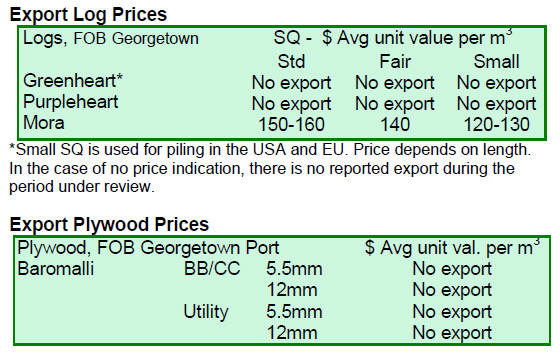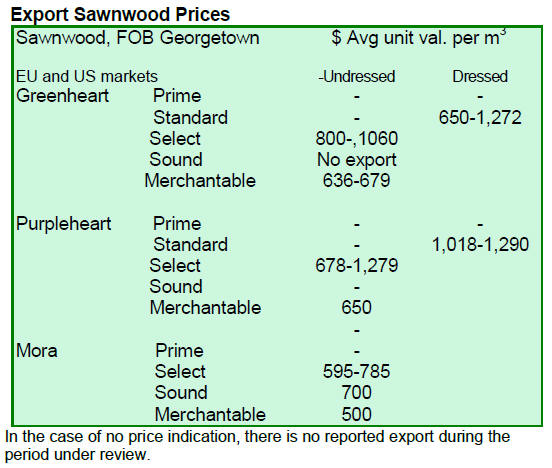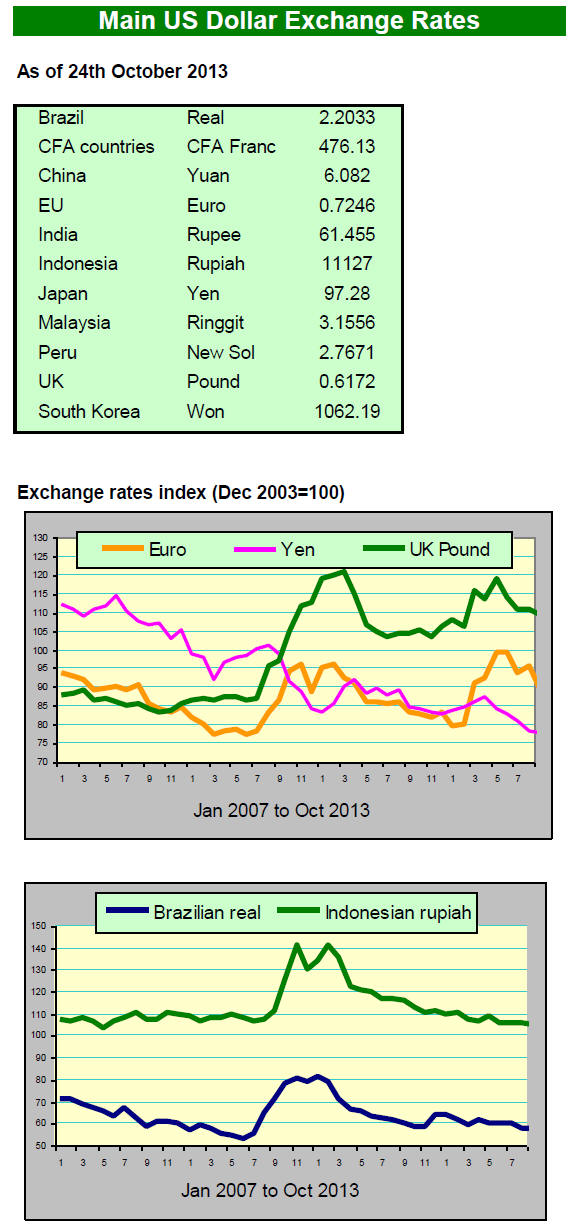2. GHANA
Rosewood export ban begin January
Ghana has announced a total ban on the harvesting and
export of rosewood, effective 1 January 2014.
The Minister for Lands and Natural Resources, Alhaji
Inusah Fuesinu said at a press conference that the ban had
been approved by Cabinet because of the indiscriminate
felling of rosewood which was high demand in
international markets.
Those companies with licenses for the export of rosewood
have a three-month period, (October to December 2013) to
continue operating until their permits expire at the end of
this year after which the Ghana Forestry Commission will
enforce the ban.
Rosewood is only found in the savannah zones of Ghana,
particularly the Northern and the Brong Ahafo regions but
harvesting has been so intense that it is being over-cut
threatening the fragile savannah forests.
Data from the Timber Industry Development Division
of
the Ghana Forestry Commission (GFC) shows that
rosewood exports in 2012 were 8,570 cubic metres while
in the first eight months of 2013 exports surged to over
18,000 cubic metres.
EU importers updated on FLEGT and VPA progress
The GFC held a stakeholder conference in London and
Brussels, on the 28th and 30th October to create awareness
of, and generate confidence in, the country‟s FLEGT and
VPA processes.
The EU is Ghana‟s largest export market for wood
products and to sustain the EU market Ghana has adopted
a FLEGT Action Plan. Ghana was the first country to
conclude the VPA (Voluntary Partnership Agreement)
negotiations with the EU in 2009 but is still in the
implementation stage.
The topics for the conferences were Ghana‟s sustainable
forest management: principles and forest governance, the
timber industry in Ghana, the Ghana FLEGT VPA process
and updates and Ghana‟s legality assurance system.
Ghana expects to be able to deliver FLEGT licensed
timber to the EU by the summer of 2014. The government
is making every effort to ensure the timber industry is
ready to satisfy the requirements of the EUTR.
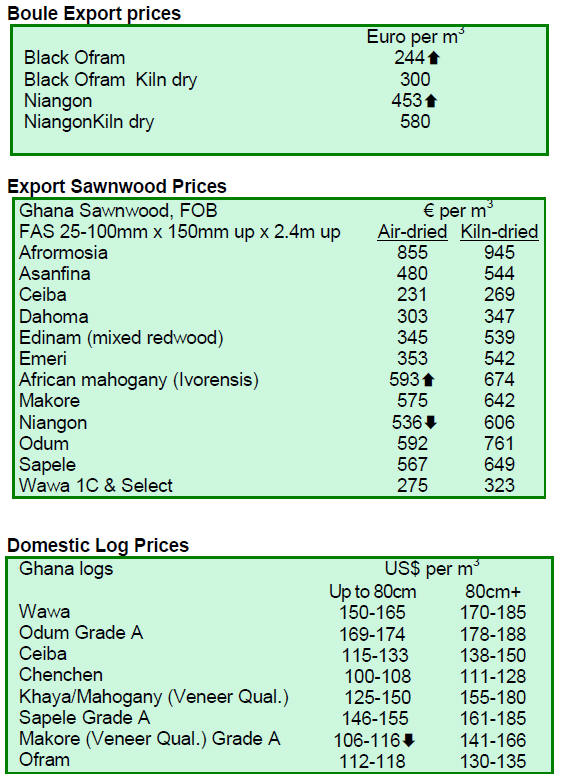
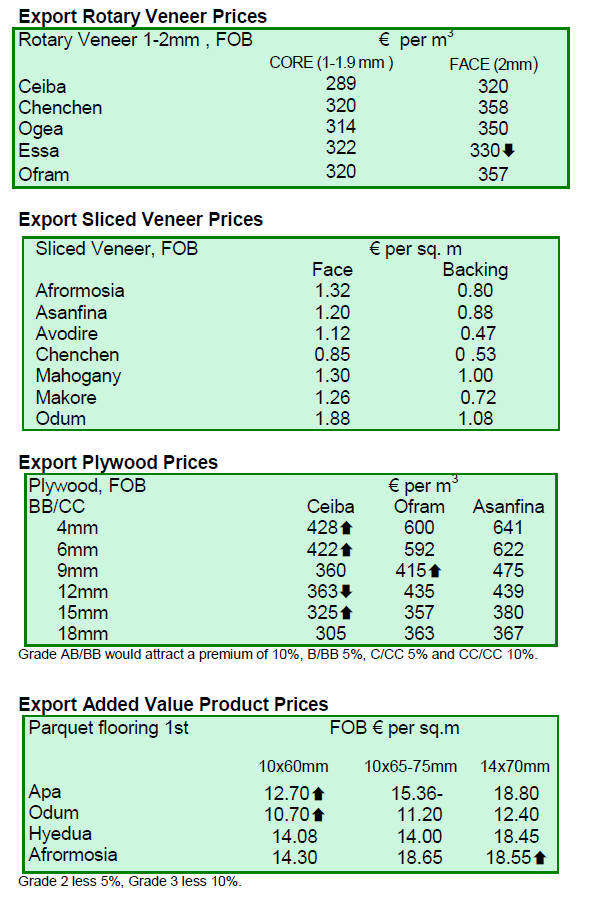
3. MALAYSIA
Budget to reduce deficit
The Malaysian Finance Minister, Najib Tun Razak, tabled
the 2014 budget on 25 October. This is designed to
gradually reduce the country‟s fiscal deficit so as to
achieve a balanced budget by year 2020.
The Finance Minister said Malaysia was on track to reduce
the deficit from 4.5% of GDP in 2012 to 4% of GDP this
year, and 3.5% of GDP in 2014.
New tax to replace sales and services tax
As part of the Government‟s fiscal consolidation
measures, Najib also announced the implementation of a
goods and services tax (GST) from April 1, 2015, at 6% to
replace the existing sales and services tax.
The business community appreciated the 17 months lead
time in which they can make the necessary adjustments. In
conjunction with the introduction of the GST, the
corporate income tax rate will be reduced by 1 percent
from 25 per cent to 24 per cent.
The tax rate for small and medium sized enterprises will
also be reduced from 20 per cent to 19 per cent from 2016.
Individual income tax rates are also to be reduced by one
to three percent for all tax payers.
Forecasts for stronger GDP in 2014
Looking to the future, Malaysia‟s inflation rate is expected
to range between 2% and 3% next year, while its economy
is projected to expand at a stronger pace of 5% to 5.5%,
driven by private investment and private consumption,
compared to the projected GDP growth of 4.5%-5% this
year.
The budget report also indicates that per capita income for
2014 is expected to reach RM34,126 (about US$ 10,850)
compared with RM24,879 in 2009, an increase of 37
percent over six years.
An unexpected but welcome announcement is the proposal
to launch an Environmental, Social and Governance Index
and the creation of Malaysian Green Foundation to
promote use of green technology among corporate sector
and the general public.
Sarawak hill and swamp forest log production
The latest log production data released by the authorities
in Sarawak show harvests for the period January to August
this year.
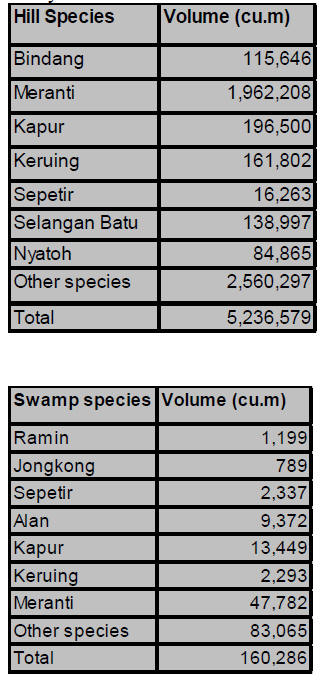
Falling revenues from forestry explained
The Director of the Forestry Department in Sabah, Sam
Mannan, has explained that the decline in timber revenue
collection was due to the policy of lowering the harvested
volumes in the natural forests to sustainable levels.
At the same time the area of totally protected forests has
been increased to 1.35 million hectares (about 20% of
Sabah‟s land area) with the long term target of protecting
two million hectares in the next 10 years.
The resources for the timber industry in Sabah are
increasingly from planted forests which, in 2011, produced
over 1 million cubic metres or around 30% of the state‟s
total production of timber. Log traders in Sarawak
reported that export FOB prices are in the following
ranges:
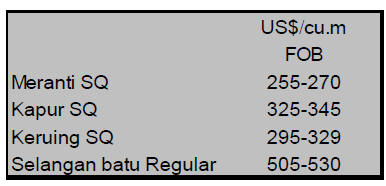
Doing business in Malaysia
The World Bank Doing Business Report 2014 identified
marked improvements in the ease of doing business in
Malaysia saying ¡°categories assessed in the report such as
¡°getting credit,¡± ¡°dealing with construction permits¡± and
¡°trading across borders¡± showed impressive progress¡±.
For the full survey results see:
http://www.doingbusiness.org/data/distance-to-frontier
However, there were negative comments regarding the
¡°paying taxes¡± category. The Bank assessment was that in
this category Malaysia had slipped from 15th rank to 36th
rank out of the 189 countries included in the most recent
survey.
The World Bank website notes, ¡°The Doing Business
2014 is the 11th in a series of annual reports published by
the World Bank and the International Financial
Corporation to investigate regulations that enhance and
constrain business activity.
Based on business investors‟ sentiments gathered from
each country, the qualitative survey measures 10 stages in
a business lifecycle ¨C starting a business, dealing with
construction permits, getting electricity, registering
property, getting credit, protecting investors, paying taxes,
trading across borders, enforcing contracts and resolving
insolvency¡±.
¡¡
4. INDONESIA
lowing FDI a short term risk but mid-term
prospects
good
In recent months the Indonesian economy has taken a
beating because of the combined effects of weak overseas
demand and fears that the US stimulus plans would be
reigned in.
The net result of these two factors has been to drive down
the value of the rupiah, currently down around 16%
against the dollar since the first quarter, and to undermine
the flow of external funds making it difficult for the
country to finance its current account deficit which was
close to 4.5% at the end of the second quarter.
In a press release the Indonesian Investment Board said
that inward investment, while increasing month on month
,the pace of flows had slowed.
For the full press release see:
http://www.bkpm.go.id/img/file/Press%20Release%20TW
%20II%202013%20-%20WARTAWAN%20-
%20FINAL%20-%20en.pdf
In the third quarter inflows were over 65 trillion rupiah
(approx. US$5.7 billion), up 18 percent from the same
period last year but down slightly on the near 19 percent
rise in inward investment in the second quarter.
The investment board blamed slower than expected global
economic recovery for the slower pace.
The slower investment growth was blamed on a change of
sentiment and the withdrawal of funds from Indonesia and
other Asian economies as the US prepares the markets for
a tapering of its stimulus programme.
However, while the FDI flow is of concern some analysts
are confident the Indonesian economy will rebound and
that annual GDP growth will return to 7-8 in the medium
term.
In the second quarter, Indonesia's GDP grew 5.8 percent
year on year and the central bank expects 2013 GDP
growth to be between of 5.8-6.2 percent.
Private sector initiatives on plantations applauded
The Indonesian Ambassador to Washington, Dino Patti
Djalal, has been highlighting government progress in
working with industry and environmental groups to protect
forests and halt its destruction.
At a meeting with various groups in the US he specifically
mentioned the efforts of Asia Pulp and Paper to switch its
raw material base from natural forest resources to
plantation resources.
The Ambassador said he was convinced the industries in
Indonesia want to change and that the government should
be ready to step in and assist them when necessary.
ASMINDO targets US$3 billion exports
Indonesian wood products are in demand globally says the
Association of Indonesian Furniture and Handicraft
Industry (Asmindo). This sector in Indonesia comprises
many small and medium sized enterprises some of which
produce only wood carving.
The head of the Marketing and Promotion Division of
Asmindo, Widayati Soetrisno, said his sector will target
the middle income groups in the international market and
will begin its marketing activities at the upcoming Trade
Expo Indonesia.
Asmindo data show that total exports of association
members reached US$1.7 billion last year and that
Asmindo is still chasing its US$3 billion target.
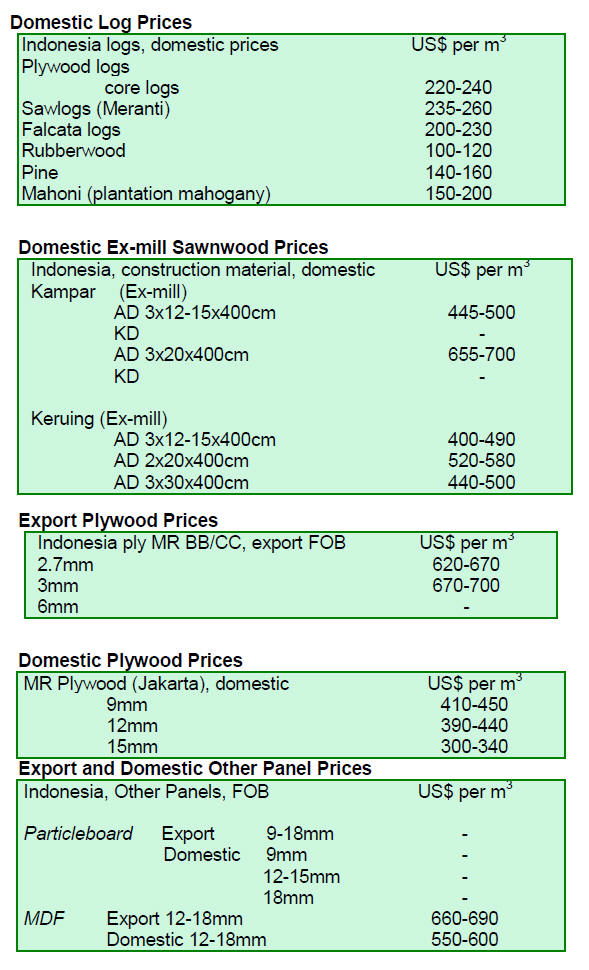
¡¡
5. MYANMAR
Strengthened rupee brings Indian buyers
back to the
log market
Log shipments picked up at the end of September
according to Myanma Timber Enterprise (MTE) officials.
Analysts point out that this was mainly due to Indian
buyers returning to the market as the Indian rupee has
recovered some of the losses against the US dollar thus
making US dollars purchases cheaper.
The Indian rupee is now around about 61.5 to the US
dollar but around twelve months ago it was as strong as 53
to the dollar which drove Indian purchases of logs higher.
Importers in Indian are obviously hoping the exchange
rate stabilises.
Singapore a major investor
Two Singaporean companies have signalled their intention
to invest in Myanmar's wood-based manufacturing and
construction sectors through a joint venture with Myanmar
counterparts.
The two Singaporean companies, Wood Craft
International and Uni-Global Power, will link up with
Myanmar companies Global Star and Nature Link to
produce finished wood products and to invest in hotels,
apartments, offices and a city mart.
Businesses in Singapore, with the strong support of the
Singaporean government, are increasing investment in
Myanmar at a time when the country is in need of capital,
technology and human resources to implement its
economic reform process for development.
According to Myanmar official statistics Singapore‟s
investment in Myanmar amounted to US$2.358 billion as
of July 2013.
Singaporean figures show that in 2012 bilateral trade
between Myanmar and Singapore reached US$2.7 billion
of which Myanmar‟s exports to Singapore amounted to
US$283million.
October teak log tender results
The following shows the grade, quantity and prices for
teak logs during the 25 and 28 October tender conducted
by the MTE.
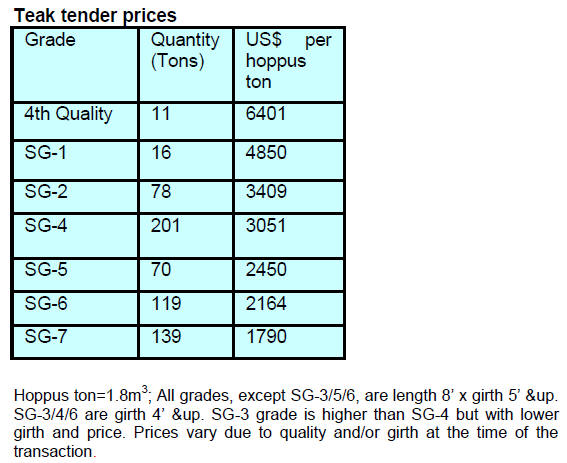
Successful bidders in the October sealed tender for
lower
grades of teak were from Thailand, India, and Myanmar.
Thailand purchased 257 tons, India purchased 66 tons and
domestic mills purchased 37 tons. It will be seen that
prices have picked up compared to levels last month.
Successful bidders in the tender sales for higher grade
natural forest teak logs were from Singapore, Japan and
Hong Kong. Singapore purchased 238 tons; Japan 38 tons
and Hong Kong 37 tons.
Prices for the better grades were also higher than the
previous month‟s tender and sealed tender sales.
¡¡
6.
INDIA
Improved economic news lifts business
sentiment
External trade data for September was in line with
expectations. Exports jumped 11.15% in US dollar terms
to US$27.7 billion, the third consecutive month of double
digit growth.
Imports, on the other hand, fell sharply by just over 18%
to US$34.44 billion, easing the worrying current account
deficit level which shrank to a two and a half year low of
US$6.7 billion.
Given the improved economic performance, business
sentiment improved and the Indian stock market reported
gains. Much of the support for improved sentiment came
from the steady appreciation of the rupee which has been
getting stronger, falling to Rs.61.20 to the US dollar
during the last week of October.
Investment in rubber plantations to create jobs
The central government has decided to increase the area of
rubber plantations in the North East of India to create jobs
for the many unemployed youth in the area.
The planned expansion of rubber plantations will generate
many positive spin-off such as improving the economy of
the area, expanding the „green cover‟, supplying much
needed raw material for the rubber and rubberwood
industries and creating social stability.
A similar measure taken earlier in Tripura, one of the nine
Maoist insurgent affected states has proved effective so
the approach is being replicated in other states such as
Jharkhand, Chhatisgarh, Odisha, parts of Maharashtra and
Madhya Pradesh. The Rubber Board plans to establish an
additional 50,000 hectare plantations in these states.
Civil society groups will help implement these plans for
economic development of the poorer parts of the country
through providing job opportunities in the rubber and
rubberwood industries.
According to the Rubber Board plan the total area under
rubber cultivation will be increased 986,000 ha. The
North Eastern states of Assam, Tripura, Meghalaya,
Manipur, Mizoram and Nagaland already have extensive
rubber plantations area ( approx. 400,000 ha) and growing
conditions here are similar to those in Kerala which has
around 550,000 ha. under cultivation.
Presently the North East has 113,685 ha. of rubber
plantations under cultivation.
Regulations changed to encourage planting of high
value woods
The governments of states where sandalwood and
agarwood grow are becoming concerned about resource
depletion and are formulating policies to encourage
planting of these valuable timbers.
Some of the legal constraints to private planting and
harvesting have been removed and the National Medicinal
Plants Board is offering farmers a 75% subsidy of planting
costs.
Because of this initiative forest village committees have
been formed to revive and protect these valuable species.
Industries using these woods are entering into agreements
with farmers to assist them in growing the trees and
offering to purchase the trees when mature.
After Independence there was a massive expansion of tree
plantations and large areas were cleared such that the stock
of medicinal plants was at risk so the current project has
been welcomed in many quarters.
Because sandalwood and agarwood are so valuable
smuggling for export to other Asian and also Middle
eastern markets resulted in these woods being placed on
the CITES list of endangered species.
During the 1950s A grade sandalwood, which was
available at Rs. 6,000 per Kg from government depots
jumped in price to as much as Rs.10,000 per kg during
auctions.
Today, good quality of Agarwood of „sinking variety‟
known as Oud-al-Gharqui, has become so rare that prices
near to or above Rs.50,000 per kg . have to be paid.
The encouragement of private planting of these two
timbers, along with a change in the regulations to allow
owners to harvest the trees, has become an attractive
proposition.
Agarwood planting has found favour with tea, coffee, and
cardamom plantation owners who see this tree as a highly
valuable shade tree to replace species such as Grevillea
and Pongamia.
Agarwood will yield a much better return than those
ordinary wood species. It has also found favour with areca
nut and coconut farmers who can interplant with the
existing tree crops.
Currently the areas under these two species are increasing.
Agarwood, which was confined to N.E. Region only, is
now being planted in southern states of Karnataka and
Andhra Pradesh. Planting of sandalwood, which was
mostly confined to the southern states, has spread to
Madhya Pradesh and Chhatisgarh.
Prices for imported plantation teak
Plantation teak shipments continue to arrive and as some
specifications have changed there have been some price
adjustments.
Current C & F prices for imported plantation teak,
Indian
ports per cubic metre are shown below.
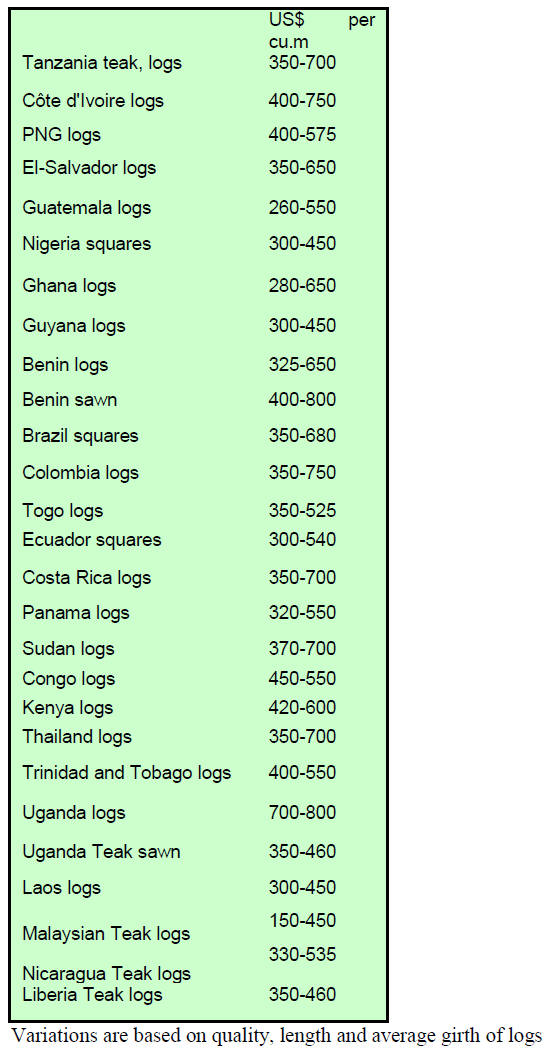
Domestic ex-sawmill prices for air dried
sawnwood cut
from imported logs
Prices per cubic foot are shown below.
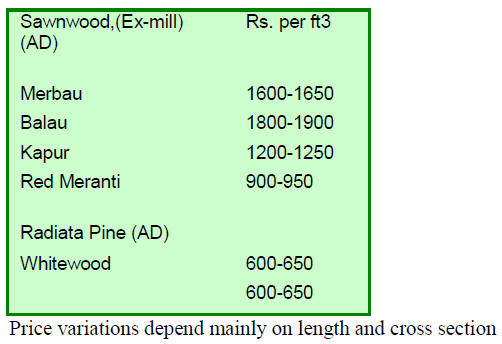
Domestic prices for Myanmar teak processed in
India
The effects of higher log landed costs are now reflected in
prices being quoted for Myanmar logs sawn by Indian
mills. Current prices are shown below.
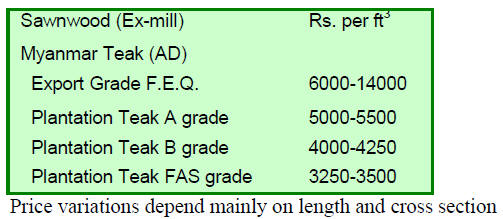
Prices for imported sawnwood
Ex-warehouse prices for imported kiln dry (12% mc.)
sawnwood per cu.ft are shown below.
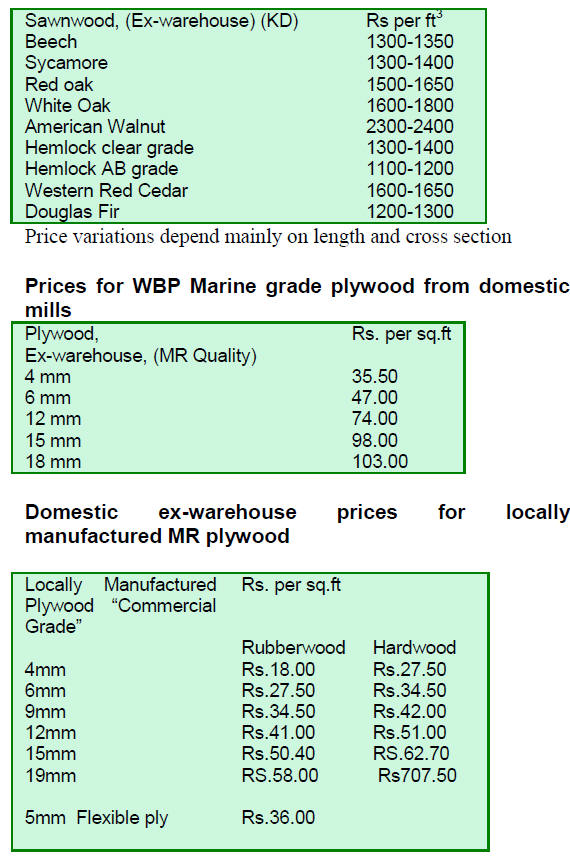
¡¡
7.
BRAZIL
Overview of trends in the economy
Brazil‟s Consumer Price Index (IPCA) closed at 0.35% in
September, up on levels during August (0.24%). In
September last year the IPCA reached 0.57%.
The high September number has pushed the accumulated
rate for the first three quarters to 3.79% so it would seem
that the government‟s target of 5.86% is within reach.
The average real:US dollar exchange rate in September
was BRL 2.27 compared to BRL 2.03 in September last
year illustrating the level of depreciation of the Brazilian
currency against the US dollar.
The Central Bank has increased the interest base rate from
9% to 9.5% per year marking the fifth consecutive
increase in the Selic rate since April.
Mato Grosso forests integrated into national forest
inventory
The Brazilian Forest Service (SFB) presented new data on
Brazil‟s forest resources at a meeting held in Cuiab¨¢, Mato
Grosso state in mid-October 2013. SFB reported on the
quality and standing volumes in the state forests as
determined during the National Forest Inventory
(Invent¨¢rio Florestal Nacional - IFN).
The purpose of the recent meeting was to provide
transparency on the resource base and explain what was
being planned for the state of Mato Grosso. For the first
time the IFN delivered information on the extent of the
forest resources, diversity of species, plant health and the
amount of forest biomass across the country.
To conduct the inventory in the Northwest region of the
state the SFB was supported by the Amazon Fund as the
work will focus on stemming deforestation. Funding of
work in the Brazilian savanna ¡°cerrado¡± areas, will be
provided from the Forest Investment Program (FIP).
IFN field work has been completed in Santa Catarina and
data is now being anlalysed in the Federal District. Work
in Rio Grande do Sul, Paran¨¢, Rio de Janeiro, Bahia,
Sergipe, Cear¨¢ and Rio Grande do Norte are at various
stages of planning and implementation of this initiative.
Illegal logging expands in Par¨¢ State
The incidence of illegal logging in the State of Par¨¢ is said
to have more than doubled between August 2011 and July
2012. Of the total 157,239 ha of forests logged, only
34,902 ha were covered by logging permits; in other
words some 78% of the areas logged were not covered by
permits.
Claims have been made that illegal logging has expanded
in the regions of Maraj¨® and the lower Amazon River.
Illegal activities were also reported in agrarian reform
settlements and protected areas such as the National Forest
(FLONA) Itaituba II, Trairão and Jamaxin.
The forest area covered by logging permits increased 8%
in the areas mentioned above but harvested volumes were
disproportionate to the increase in concession areas. It is
suspected that logging permits may have been misused by
illegal loggers who take advantage of the permit that was
granted for one area to conduct logging in an authorised
area.
Forest patrols have not been effective because when
inspectors leave the forest loggers return to continue
harvesting illegally.
To manage this situation the Par¨¢ state government
is
considering placing chips in the trees in areas where
harvesting permits have been approved to facilitate
checking the legality of harvests.
Tropical plywood exports down sharply
In September 2013, timber products export values (excl.
pulp and paper) increased 9.5% compared to values in
September 2012, from US$178.7 million to US$195.7
million.
Pine sawnwood exports increased 11.9% in value in
September 2013 compared to September 2012, from
US$13.4 million to US$15.0 million. Export volumes rose
5.4%, from 61,400 cu.m to 64,700 cu.m over the same
period.
Tropical sawnwood exports fell marginally in volume
from 28,400 cu.m in September 2012 to 28,300 cu.m in
September 2013. In terms of value earnings increased
1.4% from US$14.6 million to US$14.8 million in
September.
Pine plywood exports improved 3.9% in value in
September compared to September last year that is from
US$28.3 million to US$29.4 million. The traded volume
increased 6.8% from 76,500 cu.m to 81,700 cu.m. in
September.
During September tropical plywood export volumes fell
38%, from 5,500 cu.m last year to 3,400 cu.m in
September this year.
Wooden furniture exports increased from US$37.2 million
in September 2012 to US$40.2 million this September
2013 representing an 8% increase.
Timber exports in the first three quarters disappoint
Wood product exports in the period January to September
totaled US$1.6 billion derived form around 1.9 million
cu.m of timber. Compared to 2012, there was a 1.9%
increase in revenue and a 4.6% increase in exported
volume.
Timber exports in the same period from Mato Grosso, one
of the largest timber producing states, totalled US$77.1
million, representing a 5.8% increase in volume exported
and a 0.7% increase in value.
Plywood and flooring exports featured significantly in
Mato Grosso´s wood products trade, accounting for 47%
of total exports and generated US$36.8 million.
Compared to 2012, there was an almost 4% increase in
export volumes (25,084 cu.m), but export earnings
remained unchanged from a year ago at US$34 million.
Brazil‟s exports of plywood and flooring were worth
US$696 million in the first three quarters of the year and
the state of Mato Grosso accounted for around 13% of
this.
During the first half of 2013 Brazilian timber exports fell
4.5% in value compared to the same period in 2012
despite a 6.8% increase in exported volumes.
Bento Gonçalves furniture enterprises making a huge
contribution to state revenues
In 2012, the furniture sector in Bento Gonçalves accounts
for around 4% of formal employment in whole industry
provided work for more than 8,000 according to the
Center of Industry, Trade and Services (CIC /BG).
The furniture industry in Bento Gonçalves accounts for
12% of all companies in the state of Rio Grande do Sul
(2,470) and 2% in terms of the whole country (17,500).
According to Association of Furniture Industries of Bento
Gonçalves (Sindim¨®veis) the furniture industry in Bento
Gonçalves provides around 37% of state revenues which is
equivalent to 6% for the country (US$ 37.9 billion).
In terms of exports, Bento Gonçalves exported US$ 63
million in 2012, corresponding to 31% of exports of Rio
Grande do Sul and 9% of Brazil‟s exports.
The average price of timber products in BRL did not show
variation from the previous fortnight.
Price movements
The average price of timber products in BRL did not show
variation from the previous fortnight.
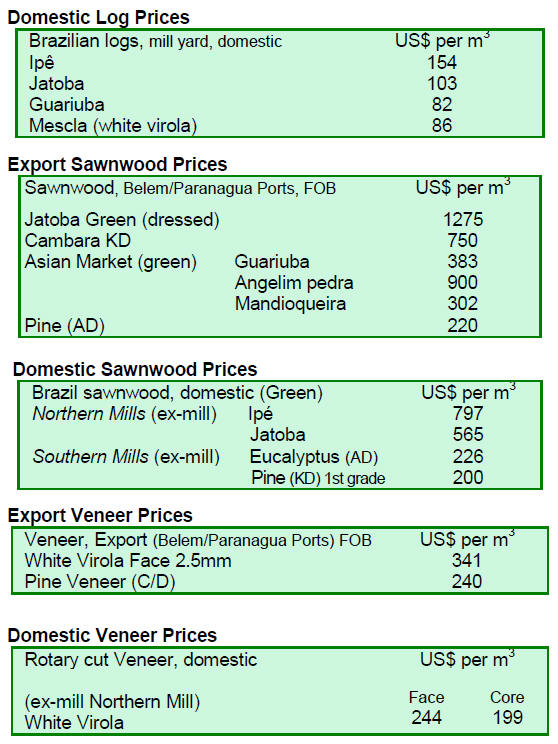
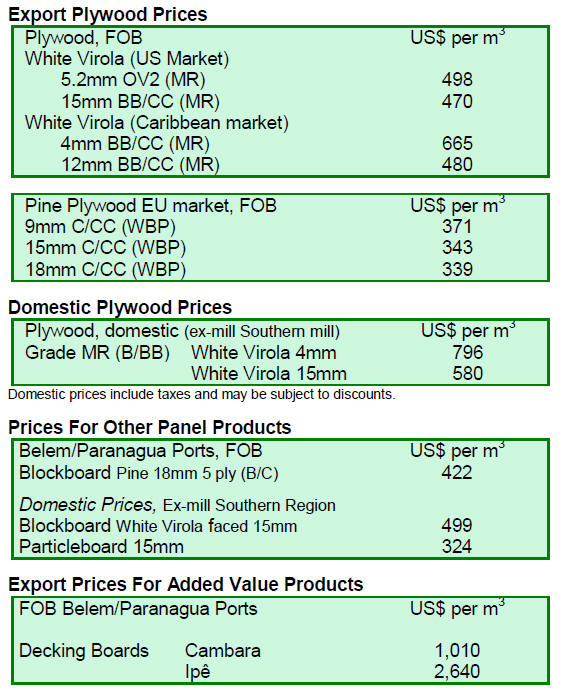
8. PERU
Woodbased panel imports reach US$ 78
million
In first eight months of 2013 imports of particleboard were
valued at US$56.2 mil. while imports of MDF totalled
US$22.1 million.
The main supplier of panels was Ecuador, with shipments
valued at US$ 24.4 million and a market share of 43.5%
for imported particleboard. The second largest supplier
was Chile at US$23 million (40.9% market share)
followed by Spain US$4.6 million (8.2% share) and
Portugal US$3 million (5.4% share).
In the first eight months the main importer was Novopan
Peru with purchases worth US$22.1 million and a share of
39.3 % of all imported particleboard followed by Arauco
Peru (21.5%), Masisa Peru (19.4%) and Representative
Martin (9.4%).
For MDF, the main supplier was Chile (US$14.7 mil., 66
% share of total imports) followed by Turkey, (US$2.6
mil. 11.8% share), Uruguay, (US$1.8 mil. 8.2% share) and
Ecuador which supplied US$1.1 mil. for a 4.9%share of
total imports of MDF.
Regulations in support of Forestry and Wildlife law
discussed
The Minister of Agriculture and Irrigation (Minagri)
Milton Von Hesse, presented details of the Forest and
Wildlife Act No. 29763 to civil society groups which have
until February next year to lodge recommendations and
observations.
After the February 2014 deadline consultations will be
held with indigenous communities as part of the
participatory process.
Already, national participatory thematic working groups
(16) have been formed to facilitate dialogue at the regional
level and to solicit contributions from other ministries
such as the Ministry of Agriculture and Irrigation,
Ministry of Environment, Ministry of Foreign Trade and
Tourism, Ministry of Culture, Ministry of Production, the
Agency for Supervision of Forest Resources and Wildlife
and regional governments.
The Ministry of Agriculture has indicated that this
regulation is complementary to other management tools
that it has developed to strengthen the sector, such as the
approval of the National Forestry and Wildlife law, the
approval of the Rules of Organization and Functions of the
National forestry and Wildlife service which will be the
new authority responsible for the stewardship of forestry
and wildlife.
In addition, there will be the National Forest Inventory
with advice from the United Nations Organization for
Food and Agriculture (FAO) and financial support from
the Government of Finland.
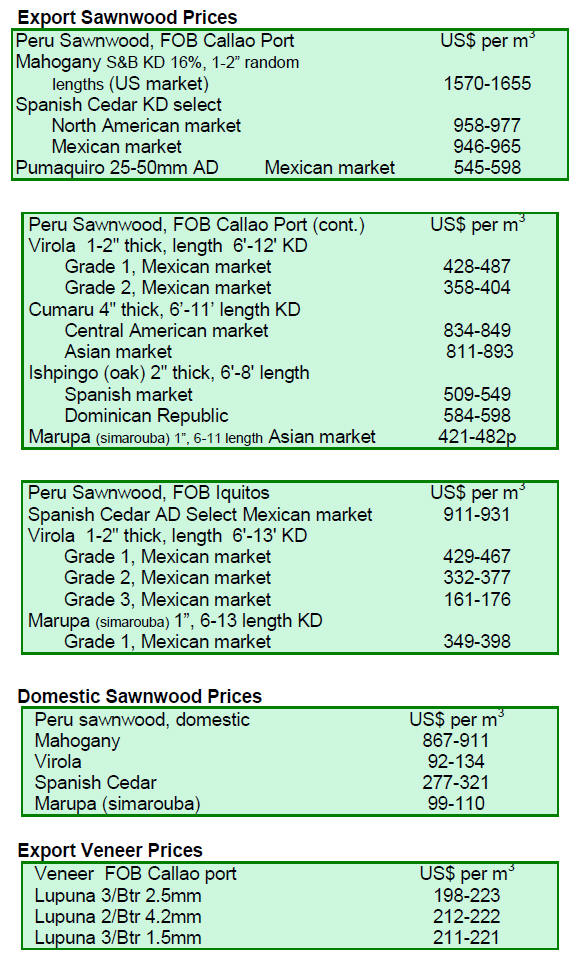
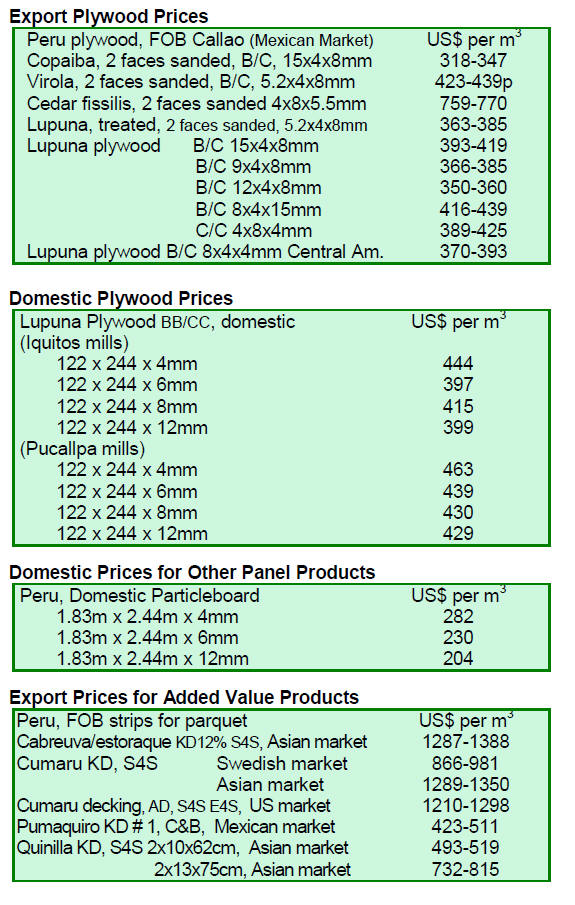
9.
GUYANA
Mora log exports resume
For the first time in a month or more mora logs were
exported but there were no exports of either greenheart of
purpleheart logs.
All the mora log categories attracted favourable prices
ranging from US$120 to US$160 per cubic metre.
Wamara (Swartzia leiocalycina) logs continue to make an
impact in the market attracting prices of US$140 per cubic
metre. The main destination for Guyana‟s logs was the
Asian market.
FOB prices soften in dull market conditions
Sawnwood made a positive contribution tototal export
earnings during the period reviewed and both undressed
and dress lumber was traded.
Undressed sawn greenheart (select) top end prices fell
from US$1,166 to US$1,060 per cubic metre FOB.
Similarly, FOB prices for Undressed sawn greenheart
(merchantable) also declined at the top end price from
US$954 to US$679 per cubic metre.
Undressed greenheart attracted buyers in the Caribbean,
Europe and North America.
Undressed sawn purpleheart select category was traded at
prices of US$1,279 per cubic metre FOB and the
Caribbean was the main market for this category.
Undressed sawn mora prices were good in the export
market. Select category sawn mora earned US$785 per
cubic metre FOB, sound category fetched a price of
US$700 per cubic metre, while merchantable quality
prices held firm at US$ 500 per cubic metre FOB. The
major market for this timber was Europe.
Dressed sawnwoodexport prices were just satisfactory.
Dressed greenheart top end prices fell from US$1,333 to
US$1,272 per cubic metre FOB. On the other hand,
Dressed purpleheart FOB prices increased from US$1,102
to US$1,290 per cubic metre.
There was no export of Baromalli plywood during the
period reviewed.
Exports of roundwood (piles, poles, and posts) made a
notable contribution tototal export earnings. Greenheart
piles secured top end FOB prices of US$600 per cubic
metre in the European and North American markets.
Wallaba poles also earned favourable FOB prices as much
as US$824 per cubic metre having secured a good
foothold in the Caribbean market. Wallaba Posts attracted
positive market prices of US$667 per cubic metre FOB.
Domestic market opportunities attracts exporter
A local company, HADCO Farm and Sawmill Inc., has
decided to target the domestic market after its success with
exports of doors, spindles, pedestals, windows,
floorboards, decorative mouldings, cabinets, doors,
kitchen cabinets, bedroom closets and dining room suites.
HADCO did well in the Caribbean, especially in Barbados
and Jamaica but is now keen is to break into the local
market which has good growth potential.
HADCO‟s processing plant has one of the country‟s
largest kiln drying facilities and is thus well equipped to
expand downstream production of added value products.
